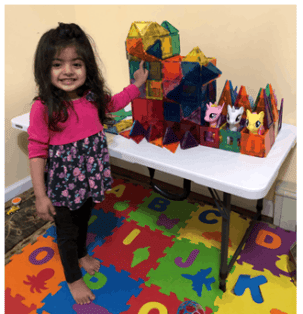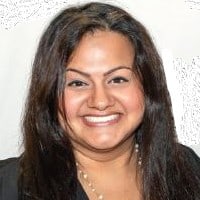“Encouraging Engineers to Fight Gender Stereotypes” was co-written by SWE Members Dr. Sreyoshi Bhaduri and Dr. Rosh Rupani.
 Raising a toddler without succumbing to gender stereotypes can sometimes be a messy process and require conscious decision-making as a parent. Rosh Rupani realized this when her three-year-old daughter, Raina, wanted to build a castle with her magnets. Together, Mom and the daughter started on the task. As they were building, Raina exclaimed, “Mama I want my ponies IN the castle!” When asked to share more about what she meant she expressed that she did not want her ponies to feel left out. She wanted a place for them, to be close to them and to be able to play with them. After all, they had been her loyal friends before and through the daycare lockdown. This felt like a revelation for Rosh, who was in awe of her child’s natural tendency towards inclusivity. Mom and daughter talked about it a bit more and as you can see in the picture, the castle was built with a pony stable.
Raising a toddler without succumbing to gender stereotypes can sometimes be a messy process and require conscious decision-making as a parent. Rosh Rupani realized this when her three-year-old daughter, Raina, wanted to build a castle with her magnets. Together, Mom and the daughter started on the task. As they were building, Raina exclaimed, “Mama I want my ponies IN the castle!” When asked to share more about what she meant she expressed that she did not want her ponies to feel left out. She wanted a place for them, to be close to them and to be able to play with them. After all, they had been her loyal friends before and through the daycare lockdown. This felt like a revelation for Rosh, who was in awe of her child’s natural tendency towards inclusivity. Mom and daughter talked about it a bit more and as you can see in the picture, the castle was built with a pony stable.
This may seem like a lesson in parenting, but it goes beyond. Engineers may relate this story to their experiences with engineering, design, and innovation.
The predominant perception regarding engineering is that it is a male-dominated and male-centric field. This perception is not surprising given that in the United States, women make up only 28% of all engineers in the workforce. Only one in every four engineers is a woman. While there are several factors that contribute to engineering not feeling inclusive, gender stereotyping and propagation of a male-dominated climate definitely top the list of contributing factors. In part because of this exclusionary climate, 40% of the women who earn degrees in engineering either quit the profession or never enter the field.
Whether one sees it as an attraction or retention problem, the truth is that there are very few women in engineering, and these numbers decline further when numbers at the intersection of race and gender minorities are investigated.
What happens when there are fewer women engineers?
Lower representation of women and women of color in engineering may lead to products that contribute to a singular narrative or cater to a specific audience. For example, think about how often women tend to complain about being cold in a shared office space with central air conditioning. This is because most buildings have their cooling system governed by an algorithm developed in the 1960s which catered to the average resting metabolic rate of middle-aged men. (Benefit of WFH: setting your own thermostat!) The result is that female employees (since their physiology is different from that of their male colleagues) are ‘freezing’ in the workplace! One wonders if this would have been the case had the algorithm development team for the air conditioning systems included more diverse participants.
Through exclusionary practices or because of gender stereotyping, women or minorities may not feel welcome to contribute their unique perspectives to the design process. For instance, societal conditioning often does not allow for what is thought of as more feminine attributes like caring, sensitivity, and empathy to co-exist with those perceived as more masculine such as relying on logic and being goal-oriented. Ideally, both types of attributes build upon each other and are independent of the person’s gender.
Who is to say that a man cannot have traditionally feminine attributes
and
that a woman cannot have traditionally masculine attributes?
Conversing with her toddler as they built the magnetic castle, Rosh realized how thoughtful her three-year-old, Raina, naturally was about others. Raina brought her loving nature to the building process – it was her “way” of doing things and she honored that part of herself by expressing her thoughts through her actions. Just as Rosh encouraged her daughter, we would like to encourage engineers to embrace all of their strengths and differences!
Bring your emotions, logic, empathy, ambition, and especially your lived experiences into your creations.
Express yourself in your creations the way a three-year-old YOU would!
Related Content
- Differences by Gender: College Freshmen’s Interest in Engineering
- Am I Doing Enough- Imposter Syndrome During COVID-19
- Podcast: Navigating Gender Bias Preferences in the Workplace
Authors
-

Dr. Sreyoshi Bhaduri is a SWE member and Vice President at SWE-NY. She currently leads Global People Research and Analytics at McGraw Hill, where she works on research leveraging employee data to generate data-driven insights for decisions impacting organizational Culture and Talent. She has interdisciplinary expertise spanning engineering, education, and statistics. Her research interests include assessing the impact and effectiveness of inclusion initiatives within the tech industry as well as employing innovative, ethical and inclusive mixed-methods research approaches using AI to uncover insights about the 21st century workforce. Learn more about her and get in touch at www.ThatStatsGirl.com.
-

Dr. Rosh Rupani is Director of Leadership and Organizational Development at McGraw Hill – she manages global learning & development initiatives to help employees and managers stretch and also partners with colleagues to identify and solve organizational gaps. She’s passionate about strategizing and at the same time likes to roll up her sleeves to get things done. Dr. Rosh loves #MakingMagicHappen which translates to being extremely resourceful and having a no-excuses mindset when it comes to execution. She immensely enjoys coaching leaders to help them explore and attain their “next best self.” Dr. Rosh is also a mother and continues to learn every day from her 3-year old daughter who teaches her about optimism, resilience, and playful learning!






